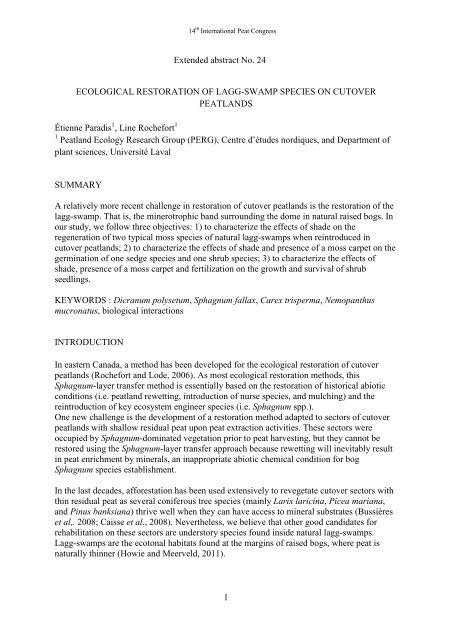Abstract No : 201/24 - Peatland Ecology Research Group ...
Abstract No : 201/24 - Peatland Ecology Research Group ...
Abstract No : 201/24 - Peatland Ecology Research Group ...
Create successful ePaper yourself
Turn your PDF publications into a flip-book with our unique Google optimized e-Paper software.
14 th International Peat CongressExtended abstract <strong>No</strong>. <strong>24</strong>ECOLOGICAL RESTORATION OF LAGG-SWAMP SPECIES ON CUTOVERPEATLANDSÉtienne Paradis 1 , Line Rochefort 11 <strong>Peatland</strong> <strong>Ecology</strong> <strong>Research</strong> <strong>Group</strong> (PERG), Centre d’études nordiques, and Department ofplant sciences, Université LavalSUMMARYA relatively more recent challenge in restoration of cutover peatlands is the restoration of thelagg-swamp. That is, the minerotrophic band surrounding the dome in natural raised bogs. Inour study, we follow three objectives: 1) to characterize the effects of shade on theregeneration of two typical moss species of natural lagg-swamps when reintroduced incutover peatlands; 2) to characterize the effects of shade and presence of a moss carpet on thegermination of one sedge species and one shrub species; 3) to characterize the effects ofshade, presence of a moss carpet and fertilization on the growth and survival of shrubseedlings.KEYWORDS : Dicranum polysetum, Sphagnum fallax, Carex trisperma, Nemopanthusmucronatus, biological interactionsINTRODUCTIONIn eastern Canada, a method has been developed for the ecological restoration of cutoverpeatlands (Rochefort and Lode, 2006). As most ecological restoration methods, thisSphagnum-layer transfer method is essentially based on the restoration of historical abioticconditions (i.e. peatland rewetting, introduction of nurse species, and mulching) and thereintroduction of key ecosystem engineer species (i.e. Sphagnum spp.).One new challenge is the development of a restoration method adapted to sectors of cutoverpeatlands with shallow residual peat upon peat extraction activities. These sectors wereoccupied by Sphagnum-dominated vegetation prior to peat harvesting, but they cannot berestored using the Sphagnum-layer transfer approach because rewetting will inevitably resultin peat enrichment by minerals, an inappropriate abiotic chemical condition for bogSphagnum species establishment.In the last decades, afforestation has been used extensively to revegetate cutover sectors withthin residual peat as several coniferous tree species (mainly Larix laricina, Picea mariana,and Pinus banksiana) thrive well when they can have access to mineral substrates (Bussièreset al,. 2008; Caisse et al., 2008). Nevertheless, we believe that other good candidates forrehabilitation on these sectors are understory species found inside natural lagg-swamps.Lagg-swamps are the ecotonal habitats found at the margins of raised bogs, where peat isnaturally thinner (Howie and Meerveld, <strong>201</strong>1).1
14 th International Peat CongressFig. 2. Germination rates of two vascular plants in full light and under shade in cutover peatlands. <strong>No</strong>te that thevertical axis is scaled differently in each graph.CONCLUSIONIn this study, we have shown that understory lagg-swamp species can be successfullyreintroduced in cutover peatlands. From the two moss species, Dicranum polysetum seemsbetter adapted to the abiotic conditions of cutover peatlands than Sphagnum fallax; its groundcover was higher in all sites after three growing seasons. Carex trisperma seems a goodcandidate species for the herbaceous layer: seeds germinated well and seedlings survived totheir first summer. The shrub Nemopanthus mucronatus also seems a good candidate species:seeds are abundant, germination rates are relatively high, and transplanted shrubs surviverelatively well in cutover peatlands. Because shrubs form the dominant layer in natural laggswamps,we think that it is important to include at least one shrub species in the restoration ofcutover bogs with thin residual peat layer. Also, other studies have shown that shrubs havegood potential in ecological restoration (Hovick and Reinartz, 2007; Gómez-Aparicio et al.,2004).Overall, the results from our three experiments showed that shade generally increasesrestoration success, at least during the early establishment of plants. Firstly, our moss-transferexperiment shows that it is possible to reintroduce lagg-swamp mosses in cutover peatlands;but shade significantly increases the cover occupied by mosses. Secondly, for the restorationof vascular plants, the two species we sown germinated well in full-light, but germinationrates were significantly higher under shade. Thirdly, for the transplanted Nemopanthusmucronatus shrubs, fertilization was the main limiting factor influencing growth, but shadesignificantly increased survival rates.In general, mosses did not influence seed germination, shrub growth and shrub survival.From a management perspective, it means that the restoration of the moss layer may be doneat any step during the restoration of the understory.5
14 th International Peat CongressACKNOWLEDGEMENTSWe would like to thank Catherine Émond and Cat Tuong Le Phat for assistance in the field.This research was made possible with the financial support of the NSERC’s Industrial<strong>Research</strong> Chair in <strong>Peatland</strong> management granted to LR and with two scholarships (FQRNTand IHQEDS) allowed to EP.REFERENCESBussières, J., Boudreau, S. and Rochefort, L. (2008). Establishing trees on cut-over peatlandsin eastern Canada. Mires and peat 3, Art. 10.Caisse, G., Boudreau, S., Munson, A.D. and Rochefort, L. (2008). Fertiliser addition isimportant for tree growth on cut-over peatlands in eastern Canada. Mires and Peat 3.Art. 11.Gómez-Aparicio, L., Zamora, R., Gómez, J.M. Hódar, J.A., Castro, J. and Baraza, E. (2004).Applying plant facilitation to forest restoration: a meta-analysis of the use of shrubs asnurse plants. Ecological Applications 14, 1128-1138.Hovick, S.M. and Reinartz, J.A. (2007). Restoring forest in wetlands dominated by reedcanarygrass: the effect of pre-planting treatments on early survival of planted stock.Wetlands 27, <strong>24</strong>-39.Howie, S.A. and Meerveld, I.T.-van (<strong>201</strong>1). The essential role of the lagg in raised bogfunction and restoration: a review. Wetlands 31, 613-622.Rochefort, L. and Lode, E. (2006). Restoration of degraded boreal peatlands. In R. K. Wiederand D. H. Vitt (eds), Boreal peatland ecosystems. pp 381-423. Springer BerlinHeidelberg.6
















